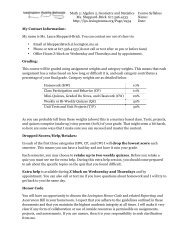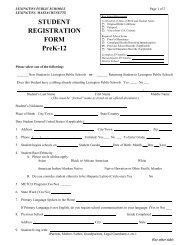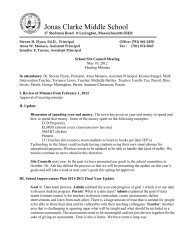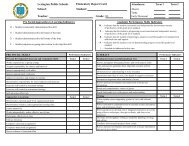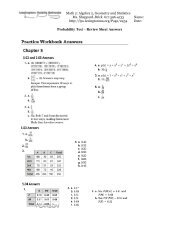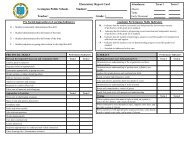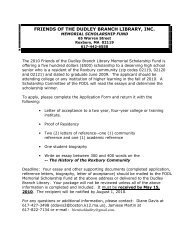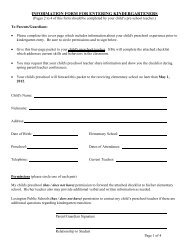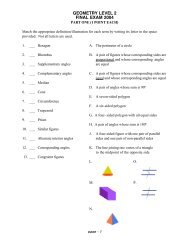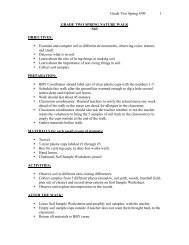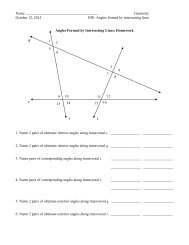answers
answers
answers
You also want an ePaper? Increase the reach of your titles
YUMPU automatically turns print PDFs into web optimized ePapers that Google loves.
Final Exam – Level 1 Geometry<br />
Ms. Andersen, Mrs. King, Mr. Shea, Ms Tee, Mr. Trainor, Mr. Williams<br />
NAME ANSWER KEY Class Date<br />
TOTAL: 103 Points [Points for each problem are indicated in the problem. ]<br />
1. The measure of the supplement of an angle is five times that of the<br />
angle’s complement. Find the measure of the complement.<br />
4 pts total<br />
[1 pt] 180 – x = 5(90 – x)<br />
[1 pt] 180 – x = 450 – 5x<br />
4x = 270<br />
[1 pt] x = 67.5<br />
Complement = 90 – 67.5 = 22.5<br />
Angle Measure = 67.5<br />
Complement = 22.5 [1 pt]<br />
<br />
2. Find x and y. AB is parallel to EC<br />
DE = 4<br />
AE = 5<br />
DC = 6<br />
EC = 7<br />
CB = y<br />
AB = x<br />
x = 15.75 [1 pt]<br />
y = 7.5 [1 pt]<br />
4 pts total<br />
E<br />
4<br />
D<br />
6<br />
C<br />
A<br />
5<br />
7<br />
x<br />
y<br />
B<br />
[1 pt]<br />
4 7<br />
=<br />
9 x<br />
4x<br />
= 63<br />
63<br />
x = = 15.75<br />
4<br />
[1 pt]<br />
6 7<br />
=<br />
6 + y 15.75<br />
42 + 7y<br />
= 15.75(6) = 94.5<br />
7y<br />
= 52.5<br />
y = 7.5<br />
06/05/03 1
Final Exam – Level 1 Geometry<br />
Ms. Andersen, Mrs. King, Mr. Shea, Ms Tee, Mr. Trainor, Mr. Williams<br />
NAME ANSWER KEY Class Date<br />
3. The vertices of a quadrilateral KOSE have coordinates as follows: Point K<br />
is (3, 2), Point O is (8, 1), Point S is (7, 6) and Point E is (2, 7). Draw and<br />
label the figure on the grid provided below.<br />
8<br />
E (2,7)<br />
6<br />
S (7,6)<br />
4<br />
2<br />
K (3,2)<br />
O (8,1)<br />
-10 -5 5 10<br />
8 pts total<br />
-2<br />
-4<br />
-6<br />
a. By finding the lengths and slopes of the sides, give the most<br />
descriptive name for the quadrilateral.<br />
-8<br />
[2 pts]<br />
Let M AB be the midpoint between<br />
2 points AB<br />
M KE = (7 - 2) / (2 - 3) = -5<br />
M KO = (2 - 1) / (3 - 8) = - 1/5<br />
M ES = (7 - 6) / (2 - 7) = - 1/5<br />
M SO = (6 - 1) / (7 - 8) = -5<br />
Name of<br />
Quadrilateral RHOMBUS [1 pt]<br />
[2 pts]<br />
LENGTHS:<br />
ES = √(25 + 1) = √26<br />
KO =√(25 + 1) = √26<br />
EK =√(1 + 25) = √26<br />
SO =√(1 + 25) = √26<br />
All sides are congruent<br />
06/05/03 2
Final Exam – Level 1 Geometry<br />
Ms. Andersen, Mrs. King, Mr. Shea, Ms Tee, Mr. Trainor, Mr. Williams<br />
NAME ANSWER KEY Class Date<br />
b. Find the mid-points of OE, KS. What other property of the<br />
quadrilateral does this show<br />
[1 pt] Midpoint of OE = (5, 4)<br />
[1 pt] Midpoint of KS = (5, 4)<br />
[1 pt] PROPERTY: Diagonals of a rhombus bisect each<br />
other.<br />
4. Use the diagram below to find x and y:<br />
x = 20<br />
y = 8<br />
132<br />
(2x + y)<br />
(5x +4y)<br />
4 pts total<br />
[1 pt] 2x + y + 132 = 180 ⇒ y = 48 – 2x<br />
[1 pt] 2x + y + 5x + 4y = 180 ⇒ 7x + 5y = 180<br />
7x + 5(48-2x) = 180<br />
3x = 5(48) – 180<br />
[1 pt] x = 20<br />
[1 pt] y = 48 – 2(20) = 8<br />
5. 3 regular polygons meet at point A. How many sides does the largest<br />
polygon have<br />
4 pts total<br />
A<br />
Number of sides =<br />
12 [1 pt]<br />
[1 pt] 120 + 90 = 210<br />
360 – 210 = 150<br />
[1 pt] (n – 2)180 = 150n<br />
180n – 150n = 360 =<br />
30n<br />
[1 pt] n = 12<br />
06/05/03 3
Final Exam – Level 1 Geometry<br />
Ms. Andersen, Mrs. King, Mr. Shea, Ms Tee, Mr. Trainor, Mr. Williams<br />
NAME ANSWER KEY Class Date<br />
6. L shaped polygon, ABCDEF<br />
y-axis<br />
B<br />
C<br />
D<br />
B’<br />
A<br />
A’<br />
E<br />
F<br />
x-axis<br />
3 pts total<br />
C’<br />
D’<br />
E’<br />
F’<br />
a. Redraw the figure: Rotate 90° clockwise (-90°) around point A,<br />
followed by a reflection across the y axis. Clearly label the final<br />
figure. [2 pts]<br />
b. How can you perform this transformation in one step [1 pt]<br />
Reflect across the line y = x<br />
06/05/03 4
Final Exam – Level 1 Geometry<br />
Ms. Andersen, Mrs. King, Mr. Shea, Ms Tee, Mr. Trainor, Mr. Williams<br />
NAME ANSWER KEY Class Date<br />
7. Refer to the figure below.<br />
Given:<br />
EA is tangent to the circle P at A<br />
Arc AB = 80°, arc CD = 140° and segment AC is a diameter<br />
4 pts total<br />
a. Find m∠1 140° [1 pt]<br />
b. Find m∠2 70° [1 pt]<br />
c. Find m∠3 70° [1 pt]<br />
d. Find m∠4 50° [1 pt]<br />
C<br />
100<br />
40<br />
P<br />
1<br />
140<br />
B<br />
2 =70<br />
70<br />
4<br />
80<br />
3<br />
40<br />
D<br />
E<br />
A<br />
1 pt total<br />
8. Which of the following is NOT a property of a parallelogram Circle your<br />
answer. [1 pt]<br />
a. Opposite sides are parallel<br />
b. Opposite angles are congruent<br />
c. Consecutive angles are supplementary<br />
d. The diagonals are congruent<br />
e. Opposite sides are congruent<br />
9. An isosceles trapezoid has bases with lengths 16 and 8. The base angles<br />
are 45°. Find the perimeter and area of the trapezoid. Leave your answer<br />
in simplest radical form.<br />
4 pts total<br />
8<br />
Trapezoid<br />
24 + 8√2<br />
Perimeter = [2 pts]<br />
4 2 4 4 2 Trapezoid Area = 48 [ 2 pts]<br />
4 8<br />
4<br />
16<br />
06/05/03 5
Final Exam – Level 1 Geometry<br />
Ms. Andersen, Mrs. King, Mr. Shea, Ms Tee, Mr. Trainor, Mr. Williams<br />
NAME ANSWER KEY Class Date<br />
10. In the diagram below, ABCD is a rectangle. Find the measure of ∠EFG.<br />
E<br />
2 pts total<br />
C<br />
60°<br />
60°<br />
120°<br />
D<br />
Measure ∠EFG = 80<br />
F<br />
20°<br />
20°<br />
160°<br />
A<br />
G<br />
B<br />
Draw line XF which will be parallel to ED and AB and<br />
label.<br />
11. To find the distance from point A on the shore of a lake to point B on an<br />
island in that lake, surveyors locate a point P with ∠PAB = 65° and ∠<br />
APB = 25°. They find that PA measures 352 meters. Find AB to the<br />
nearest 10 th .<br />
_ A<br />
2 pts total<br />
_ B<br />
_ P<br />
sin 25° = AB / 352<br />
AB = 352 (sin 25°)<br />
AB = 148.8<br />
06/05/03 6
Final Exam – Level 1 Geometry<br />
Ms. Andersen, Mrs. King, Mr. Shea, Ms Tee, Mr. Trainor, Mr. Williams<br />
NAME ANSWER KEY Class Date<br />
12. All soccer players are athletes<br />
a. Rewrite the above statement in if… then… form. [1 pt]<br />
If you are a soccer player, then you are an athlete.<br />
7 pts total<br />
b. Write the converse, inverse and contrapositive forms of your<br />
answer for a. [1 pt each]<br />
Converse: If you are an athlete then you are a soccer player.<br />
Inverse: If you are not a soccer player, then you are not an<br />
athlete.<br />
Contrapositive: If you’re not an athlete, then you’re not a soccer player.<br />
c. Make a Venn diagram to illustrate the statement. [1 pt]<br />
Athletes<br />
Soccer<br />
Players<br />
d. If the given statement is true, what can you conclude from each of<br />
the following statements If no conclusion can be made, write<br />
NONE.<br />
[1/2 pt each]<br />
1. Molly is an athlete. NONE<br />
2. John plays soccer. John is an athlete<br />
3. Dave is not a soccer player. None<br />
4. Rachel is not an athlete. Rachel is not a soccer player<br />
06/05/03 7
Final Exam – Level 1 Geometry<br />
Ms. Andersen, Mrs. King, Mr. Shea, Ms Tee, Mr. Trainor, Mr. Williams<br />
NAME ANSWER KEY Class Date<br />
13. Find BD:<br />
_ A<br />
BD = 6 [2 pts]<br />
60°<br />
_ D<br />
2 pts total<br />
_ 4<br />
30°<br />
_ C<br />
_ B<br />
Use 30-60-90 ratios to find values.<br />
Find sides for ACD first:<br />
Hypotenuse (AC) = 4<br />
Short leg (AD) = 2<br />
Long leg (CD) = 2√3<br />
Then use 30-60-90 ratios again to find sides for BCD<br />
to find BD<br />
Short leg (CD) = 2√3<br />
Long leg (BD) = (2√3)(√3) = 6<br />
06/05/03 8
Final Exam – Level 1 Geometry<br />
Ms. Andersen, Mrs. King, Mr. Shea, Ms Tee, Mr. Trainor, Mr. Williams<br />
NAME ANSWER KEY Class Date<br />
14. PT is tangent to circle O at point T. Find the radius of the circle O.<br />
4 pts total<br />
XP = 9<br />
TP = 15<br />
_ O<br />
_ T<br />
_ 9<br />
_ X<br />
_ 15<br />
_ P<br />
4 pts total<br />
Draw radius OT perpendicular to PT at point T. [ 1 pt<br />
]<br />
Let x be the radius of the circle O<br />
This will form a right triangle: POT:<br />
Hypotenuse = OP = x + 9<br />
Leg 1 = OT = x<br />
Leg 2 = PT = 15<br />
[ 1 pt ] Pythagorean Theorem: x 2 + 15 2 = (9 + x) 2<br />
[ 2 pt ]Solve for x:<br />
81 + 18x + x 2 = 15 2 + x 2<br />
18x = 15 2 – 81 = 225 – 81 = 144<br />
x = 144 / 18 = 8<br />
15. ABCD is an inscribed quadrilateral with the measure of the minor arc AB =<br />
60° and the measure of minor arc BC = 90°. The ratio of the measure of<br />
the minor arc CD to the measure of the minor arc DA is 2:1. Setup a<br />
diagram<br />
using this information and find the m<br />
∠BCD. [ 1 CD = 2x = 140 pt for diagram]<br />
D<br />
Radius of Circle O = 8<br />
C<br />
m ∠BCD = 65° [ 1 pt ]<br />
DA = x = 70<br />
BC = 90°<br />
[ 2 pts ]<br />
3x= 360 – (90+60)<br />
B<br />
A<br />
06/05/03 9<br />
AB = 60°
Final Exam – Level 1 Geometry<br />
Ms. Andersen, Mrs. King, Mr. Shea, Ms Tee, Mr. Trainor, Mr. Williams<br />
NAME ANSWER KEY Class Date<br />
x = 1/3 (420)<br />
16. Find the area of the shaded region. Leave your answer in terms of π.<br />
6 cm<br />
_<br />
_<br />
10 cm<br />
Area of shaded<br />
region = 60 + 8π<br />
The figure consists of a rectangle with a semi-circle<br />
cut out of it and another semicircle on top.<br />
4 pts total<br />
The rectangle has sides 6 and 10.<br />
The semi-circle cut out of the rectangle has a<br />
diameter of 6, hence a radius of 6<br />
The semi-circle cut outside the rectangle has a<br />
diameter of 10, hence a radius of 5<br />
[ 1 pt ] Area of Rectangle = 6 * 10 = 60<br />
[ 1 pt ] Area of semi-circle inside rectangle = ½(π 3 2 )<br />
= (9/2)π<br />
[ 1 pt ] Area of semi-circle outside rectangle = ½(π5 2 )<br />
= (25/2)π<br />
The area of the figure (shaded region) is:<br />
[ 1 pt ] 60 - (9/2)π + (25/2)π = 60 + (16/2)π = 60 +<br />
8π<br />
06/05/03 10
Final Exam – Level 1 Geometry<br />
Ms. Andersen, Mrs. King, Mr. Shea, Ms Tee, Mr. Trainor, Mr. Williams<br />
NAME ANSWER KEY Class Date<br />
17. Find x:<br />
_ H<br />
_ I<br />
_ 8<br />
_ 18<br />
X = 6.75<br />
_ x<br />
_ J<br />
_ 3<br />
4 pts total<br />
_ L<br />
_ K<br />
[ 1 pt ] HI / KL = IJ / LJ = HJ / KJ<br />
[ 2 pt ] 3 / x = 8 / 18<br />
8x = 54<br />
[ 1 pt ]x = 6.75<br />
18. Given:<br />
WU bisects ∠TWV<br />
VU bisects ∠ TVW<br />
∠T = 80°<br />
4 pts total<br />
Find ∠WUV<br />
T<br />
∠WUV = 130° [ 1 pt]<br />
W<br />
U<br />
V<br />
Let x = ∠UWV and also ∠TWU<br />
Let y = ∠UVW and also ∠TVU<br />
[ 2 pt] 2x + 2y + 80 = 180<br />
[ 1 pt] x + y = 50 and [ 1 pt] ∠WUV = 180 – 50 = 130°<br />
06/05/03 11
Final Exam – Level 1 Geometry<br />
Ms. Andersen, Mrs. King, Mr. Shea, Ms Tee, Mr. Trainor, Mr. Williams<br />
NAME ANSWER KEY Class Date<br />
19.<br />
12<br />
12<br />
33<br />
33<br />
18 18<br />
24 10 24<br />
4 pts total<br />
How far does Juan walk if he goes from H to K to P to O to M to K [4 pts]<br />
HK = 34<br />
KP = 18<br />
PO = 12<br />
OM = 33<br />
MK = 24<br />
Total : 121 units<br />
06/05/03 12
Final Exam – Level 1 Geometry<br />
Ms. Andersen, Mrs. King, Mr. Shea, Ms Tee, Mr. Trainor, Mr. Williams<br />
NAME ANSWER KEY Class Date<br />
20. [2 pts for midpoints]<br />
_ 8<br />
_ 6<br />
(2, 5)<br />
A<br />
_( 5 , 7 )<br />
_ K<br />
_ L<br />
_(- 1 , 3 )<br />
_ 4<br />
_ 2<br />
B<br />
(7,3)<br />
(-1,1)<br />
D<br />
_- 10 _- 5 _ 5 _ 10<br />
_(- 1 ,- 1 ) _ M<br />
_- 2<br />
C<br />
(4, -1)<br />
(9, -1)<br />
_ J<br />
_- 4<br />
5 pts total<br />
_- 6<br />
_- 8<br />
Prove that the quadrilateral ABCD formed by joining the midpoints of KJML is<br />
a parallelogram.<br />
[2 pts]<br />
Prove by Slope to show opposites sides are parallel:<br />
Slope of AD = (5 – 1) / (2 – (-1)) = 4/3<br />
Slope of BC = (3 – (-1)) / (7 – (4)) = 4/3<br />
Slope of DC = (1 – (-1)) / (-1 – 4) = -2/5<br />
Slope of AB = (5 – 3) / (2 – 7) = -2/5<br />
OR Prove by distance to show opposites sides are<br />
congruent<br />
AD = 5<br />
DC = √29<br />
BC = 5<br />
AB = √29<br />
[1 pt] ABCD is a parallelogram<br />
06/05/03 13
Final Exam – Level 1 Geometry<br />
Ms. Andersen, Mrs. King, Mr. Shea, Ms Tee, Mr. Trainor, Mr. Williams<br />
NAME ANSWER KEY Class Date<br />
21. Find the labeled angles:<br />
Given: L2 L3<br />
_ A<br />
_ B<br />
_ L 2<br />
_ C<br />
_ E<br />
_ 98<br />
_ K<br />
_ 116<br />
_ 116<br />
_ D<br />
_ F<br />
_ 138<br />
_ G<br />
_ J<br />
_ I<br />
L<br />
_<br />
_ N O<br />
_ 122<br />
_ H<br />
M<br />
_<br />
P<br />
_ L 3<br />
[1/2 pt each – 8 points total]<br />
A. 99<br />
B. 99<br />
C. 98<br />
D. 64<br />
E. 82<br />
F. 116<br />
G. 64<br />
H. 90<br />
I. 116<br />
J. 64<br />
K. 82<br />
L. 116<br />
M. 90<br />
N. 88<br />
O. 150<br />
P. 56<br />
06/05/03 14
Final Exam – Level 1 Geometry<br />
Ms. Andersen, Mrs. King, Mr. Shea, Ms Tee, Mr. Trainor, Mr. Williams<br />
NAME ANSWER KEY Class Date<br />
22. Given:<br />
DE AB<br />
EF AD<br />
ACB is an isosceles triangle<br />
Prove:<br />
△CDE<br />
∼△EFB<br />
_ A<br />
Triangle CDE is similar to Triangle EFB<br />
_ D<br />
_ F<br />
[5 pts]<br />
_ C<br />
_ E<br />
_ B<br />
Statement<br />
Reason<br />
1. DE is parallel to AB and EF is Given<br />
parallel to AD<br />
2. ∠2 = ∠4 and ∠4 = ∠9 F Thm (corresponding ∠’s)<br />
3. ∠2 = ∠9 Transitive<br />
4. ADEF is a parallelogram Dfn of a parallelogram, opp sides are<br />
parallel<br />
5. ∠3 = ∠5 Opp ∠’s are congruent<br />
6. ∠3 = ∠7 and ∠5 = ∠8 Z Thm (alternate interior ∠’s)<br />
7. ∠7 = ∠8 Transitive<br />
8. Triangle CDE is similar to Triangle AA<br />
EFB<br />
06/05/03 15
Final Exam – Level 1 Geometry<br />
Ms. Andersen, Mrs. King, Mr. Shea, Ms Tee, Mr. Trainor, Mr. Williams<br />
NAME ANSWER KEY Class Date<br />
23. Given:<br />
AD is the altitude to base BC<br />
AD bisects ∠BAC<br />
Prove:<br />
A<br />
AD is the median to BC<br />
C<br />
D<br />
B<br />
[5 pts]<br />
Statement<br />
Reason<br />
1. AD is altitude to BC<br />
Given<br />
AD bisects ∠BAC<br />
2. ∠1 = ∠2 Dfn of Bisector<br />
3. AD perpendicular to BC Dfn of Alt.<br />
4. ∠ACD and ∠ADB are right angles Dfn of Rt ∠s and rt ∠s = 90°<br />
and 90°<br />
5. AD = AD Reflexive<br />
6. Triangle ACD = Triangle ABD ASA<br />
7. CD = BD CPCTC<br />
8. AD is median to BC Dfn of medians<br />
06/05/03 16
Final Exam – Level 1 Geometry<br />
Ms. Andersen, Mrs. King, Mr. Shea, Ms Tee, Mr. Trainor, Mr. Williams<br />
NAME ANSWER KEY Class Date<br />
24. Given<br />
ABCD is a parallelogram<br />
▱ABCD<br />
AF ≅ GC<br />
GH ⊥ AC<br />
EF ⊥ AC<br />
Prove: EC = AH<br />
D<br />
G<br />
E<br />
F<br />
C<br />
[5 pts]<br />
A<br />
H<br />
B<br />
Statement<br />
▱ABCD<br />
Reason<br />
Given<br />
1.<br />
AF ≅ GC<br />
GH ⊥ AC<br />
EF ⊥ AC<br />
2. AB parallel to CD and AD parallel to Opp sides of parallelogram are parallel<br />
BC<br />
3. ∠HAG = ∠ECF Z Thm (Alt Int angles)<br />
4. ∠HGA and ∠EFC are right ∠s Perpendicular lines<br />
∠HGA = ∠EFC<br />
Rt ∠’s are congruent<br />
5. GF = GF Reflexive<br />
6. AG = CF Subtraction<br />
7. Triangle HAG = Triangle FCE ASA<br />
8. EC = AH CPCTC<br />
06/05/03 17



